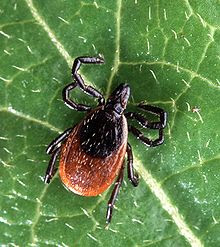We begin our tick breakdown with the American Dog Tick. The name leaves little need for further explanation, one would think, but in the spirit of informative blogging let's describe this pedestrian parasite a bit: Also known as the wood tick, the American Dog Tick is not dog-specific strangely. It likes smaller animals, including small rodents and birds. It was probably given the aforementioned name because humans encounter so often on our "best friend." It also likes raccoon, too. But who doesn't really? Females have a grayish spot behind their tiny little heads, and grow up to the size of a grape after a full meal. Males don't grow as much after feeding and can be distinguished by the silver lines on their backs. These play a big role in the spread of Rocky Mountain spotted fever.
Then there's the lone star tick. It's not as scary as the dog Tick, and it's about half the size and varying in color. They typically don't spread as many diseases as dog ticks, but may be associated with an as yet unidentified bacteria that mimics the behavior of Lyme Disease.
 |
| Adult Deer Tick |
Finally, there's the winter tick, the most innocuous of the bunch, at least to humans, anyway. They feed on larger game animals, like antelope and horses. They've been known to pass infection between larger mammals, but few recorded instances of human diseases have been caused by the winter tick.
No comments:
Post a Comment